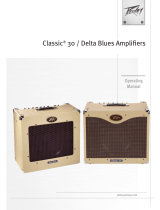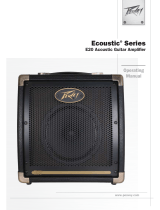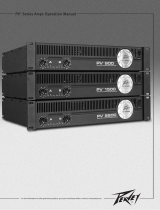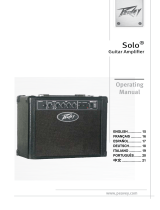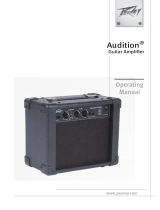PPRREEAAMMPP SSEECCTTIIOONN
The following preamp specs are
measured @ 1 kHz‚ nominal signal
levels are with channel level controls
set at 5‚ minimum levels are with
channel level controls set at 10.
CChhaannnneell 11‚‚ 22 aanndd 33 iinnppuuttss::
Input Impedance: 100 k‚ Left/Mono
Nominal Input Level: -22 dBV‚ 79 mV RMS
Minimum Input Level: -40 dBV‚ 10 mV RMS
Nominal Input Level: -15 dBV‚ 178 mV RMS
Minimum Input Level: -33 dBV‚ 22 mV RMS
CChhaannnneell 44 iinnppuutt::
Low Z Input Impedance: 5 k Ohms
Nominal Input Level: -28 dBV‚ 40 mV RMS
Minimum Input Level: -48 dBV‚ 4 mV RMS
High Z Input Impedance: 100 l‚ Left
Nominal Input Level: -5 dBV‚ 560 mV RMS
Minimum Input Level: -22 dBV‚ 79 mV RMS
Right: -1 dBV‚ 1.1 V RMS
Minimum: -16 dBV‚ 158 mV RMS
HHeeaaddpphhoonnee oouuttppuutt
Load Impedance: 8 Ohms or greater
Nominal Output: 100 mW RMS
MMaaiinn lliinnee oouutt
Output Impedance: <100
Output Level: 18 dBV
PPOOWWEERR AAMMPPLLIIFFIIEERR SSEECCTTIIOONN
RRaatteedd ppoowweerr aanndd llooaadd::
200 Watts RMS/4 Ohms or 150 Watts
RMS/8 Ohms with DDT off
(1 kHz, 1% THD @ 120 VAC line)
FFrreeqquueennccyy rreessppoonnssee::
+0, -1dB, 20Hz–20kHz @ 100 Watts RMS/
8 Ohms
TToottaall hhaarrmmoonniicc ddiissttoorrttiioonn::
Less than 0.01% @ 1 kHz/8 Ohms
Typically less than 0.08%‚ 20 Hz–20kHz
DDDDTT ddyynnaammiicc rraannggee::
Greater than 20 dB
DDDDTT mmaaxxiimmuumm TTHHDD::
Below 0.5% THD for 6 dB overload
Below 1% THD for 20 dB overload
HHuumm aanndd nnooiissee::
Greater than 100 dB below rated power
PPoowweerr ccoonnssuummppttiioonn::
300 Watts @ 120V AC‚ 50/60 Hz‚ domestic
300 Watts @ 220–230/240V AC‚ 60 Hz‚ export
KKBB55
EESSPPEECCIIFFIICCAACCIIOONNEESS
KKBB44
EESSPPEECCIIFFIICCAACCIIOONNEESS
PPRREEAAMMPP SSEECCTTIIOONN
The following preamp specs are
measured @ 1 kHz‚ nominal signal
levels are with channel level controls
set at 5‚ minimum levels are with
channel level controls set at 10.
CChhaannnneell 11 aanndd 22 IInnppuuttss::
Input Impedance: 100 k‚ Left/Mono
Nominal Input Level: -22 dBV‚ 79 mV RMS
Minimum Input Level: -40 dBV‚ 10 mV RMS
Nominal Input Level: -15 dBV‚ 178 mV RMS
Minimum Input Level: -33 dBV‚ 22 mV RMS
CChhaannnneell 33 IInnppuutt::
Low Z Input Impedance: 5 k Ohms
Nominal Input Level: -28 dBV‚ 40 mV RMS
Minimum Input Level: -48 dBV‚ 4 mV RMS
High Z Input Impedance: 100 k‚ Left
Nominal Input Level: -5 dBV‚ 560 mV RMS
Minimum Input Level: -22 dBV‚ 79 mV RMS
Right: -1 dBV‚ 1.1 V RMS
Minimum: -16 dBV‚ 158 mV RMS
HHeeaaddpphhoonnee OOuuttppuutt
Load Impedance: 8 Ohms or greater
Nominal Output: 100 mW RMS
MMaaiinn LLiinnee OOuutt
Output Impedance: <100
Output Level: 18 dBV
PPOOWWEERR AAMMPPLLIIFFIIEERR SSEECCTTIIOONN
RRaatteedd PPoowweerr aanndd LLooaadd::
100 Watts RMS/4 Ohms or 75 W
RMS/8 Ohms with DDT off
(1 kHz, 1% THD @ 120 VAC line)
FFrreeqquueennccyy RReessppoonnssee::
+0, -1dB, 20 Hz–20 kHz @ 60 Watts RMS/
8 Ohms
TToottaall HHaarrmmoonniicc DDiissttoorrttiioonn::
Less than 0.01% @ 1 kHz/8 Ohms
Typically less than 0.08%‚ 20 Hz–20kHz
DDDDTT DDyynnaammiicc RRaannggee::
Greater than 20 dB
DDDDTT MMaaxxiimmuumm TTHHDD::
Below 0.5% THD for 6 dB overload
Below 1% THD for 20 dB overload
HHuumm aanndd NNooiissee::
Greater than 100 dB below rated power
PPoowweerr CCoonnssuummppttiioonn::
150 Watts @ 120V AC‚ 50/60 Hz‚ Domestic
150 Watts @ 220–230/240V AC‚ 60 Hz‚ Export
















